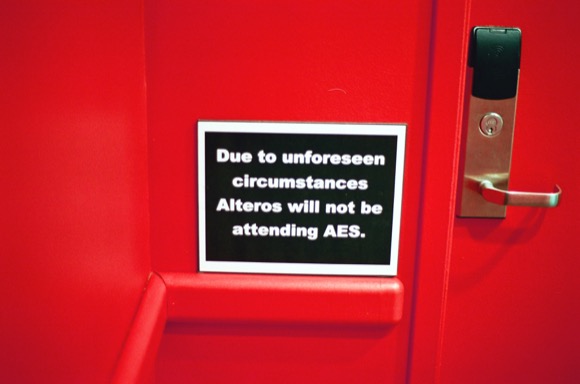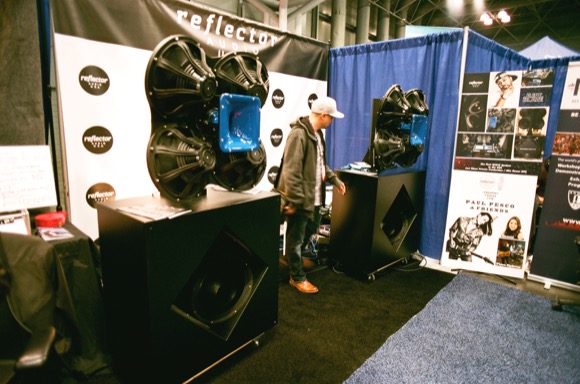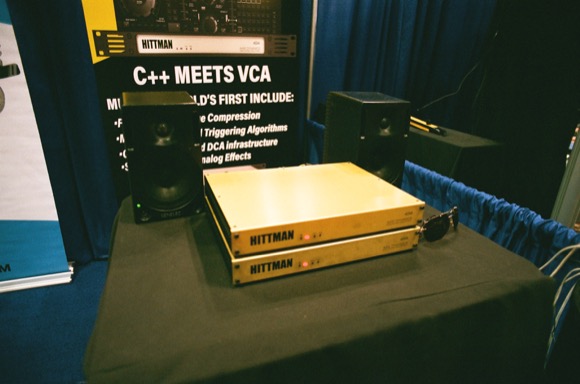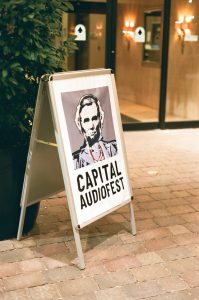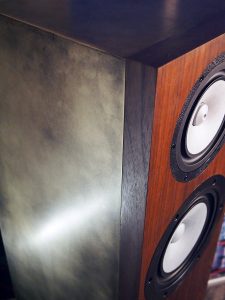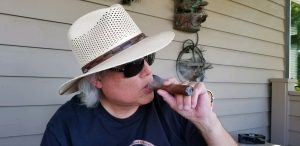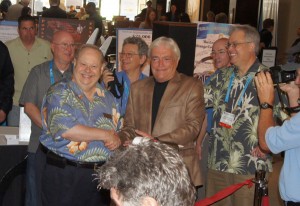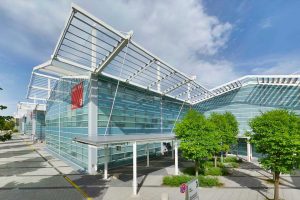The thing about the AES show is that it's traditionally been two shows: a trade show run by marketing people upstairs, selling off all the latest new pro audio hardware, while downstairs there are scientists and engineers talking about the latest new technology. What makes the AES different than any other show is that it provides a place for these groups to have some common contact. To that aim, in recent years the AES has done an increasing number of workshops and tutorials that are aimed at both groups of people. This year I found more interesting ones than ever before, even when I didn't see quite as many exciting papers or products. So this year's show review is a little different because to me the show was a little different. Be aware also that I am only one person and there are many different things going on at the same time, so if I missed your favorite thing it's likely not a deliberate omission. I doubt I see more than 10% of the parts of the event that I want to see. Also, I'll point out that for the third year running we were co-located in the Javits center with the National Association of Broadcasters meeting and that your ticket would get you onto the NAB show floor as well. So I am mentioning a couple of items here from the NAB which jumped out at me.
Before anything else, I want to say that the keynote speaker for the show was Grandmaster Flash, and I was prepared to dismiss his presentation but to be honest I have to say that it was probably the best keynote speech I have ever seen at an AES show. He talked about where the practice of using turntables as instruments came from, and then gave a demonstration of keeping a beat using multiple copies of the same record, playing from white crayon marks on the discs for synchronization. What made this so fascinating was that he described exactly what was going on, he counted off the beats and rotations, and he explained exactly the process that went through his head when he effectively put a piece of music together using individual bars from records pieced together in real time. Although I couldn't help but think that this could be done so much more easily with a tape machine and a razor blade, these folks didn't have a tape machine or the money for a tape machine. So they figured out a way to get the sound they wanted with the equipment they had, and that is what audio engineering is all about. So hats off to Grandmaster Flash (and to his skilled assistant who was always behind him, handing him the next record in the series) for explaining turntablism as an art form in a way that even classical music people could understand it.
Acoustics
In addition to all the usual suspects like Soundproof Windows, Inc. and GIK Acoustics, a bunch of new companies were showing off acoustical treatments of the sort that are at home in both studios and listening rooms. Prosocoustic had a line of inexpensive diffusion panels that were about half the cost of the big names with comparable specifications and materials. Jocavi is an old name in the acoustical business in Europe although fairly new to these shores, and they were showing off cork materials. Cork has been used for acoustical absorption for a few hundred years, but it's funny stuff to work with and not flat across as a wide band. Buying calibrated materials like these, where you know what absorption to expect at what frequency, allows you to use materials like this as part of a complete room treatment plan and know what you're going to be getting in advance. IsoAcoustics was showing isolation pucks and stands for monitor speakers and are able to show actual measurements of how reducing sound conducted into your desk or table can improve the quality of your low end.
A new material that has apparently been seen in Europe but not so much on these shores is "microperforated foil," a metal that has been finely perforated to the point where it has substantial sound absorption. In Transparent Office Screens Based on Microperforated Foil, Krzystof Brawata and others sandwich a layer of heavy plexiglas between two layers of this foil to provide an effective sound baffle that remains transparent. The absorption is not as good as a proper fiberglass absorber and is very limited below 1kHz, but still useful in office applications. Something like this might also be useful on stage as a gobo, probably more effective than just a simple Plexiglas box for drummers. AES Convention Paper 10282. Everybody and his brother is selling some automatic room correction filter. In An Investigation into the Effectiveness of Room Adaptation Systems: Listening Test Results, Pei Yu and others from Nanjing University tested out four different algorithms in two different rooms with experienced listeners. The test done in the first room didn't have a proper control group and can't be usefully interpreted. The test done in the second room show that a system that creates a filter with a direct inverse of the whole spectrum degrades the sound considerably, while two filters that attempt only low frequency boundary equalization seem to improve it. A "global adaptation system" employing multiple measurements and an undescribed filter arrangement appears to slightly degrade it. Listener position has an effect on the degree to which effects are perceived. This once again shows that full spectrum equalization does more harm than good, but room boundary equalization can help a lot for speakers which may not be perfectly positioned for flat low frequency response. AES Convention e-Brief 530.
Microphones
AEA Microphones was showing off their KU5A microphone which appears to be derived from the classic RCA BK-5 cardioid ribbon microphone, long used in the film industry as a boom mike. Wes Dooley says it's very much like a BK-5 but the advertising copy says "You've Never Heard A Mike Like This" so I guess we'll have to wait until they send a review one to find out for sure. Manley Laboratories was celebrating the 30th anniversary of their Reference Cardioid large diaphragm microphone. This has become something of a studio standard and a favorite vocal microphone, and their new edition out this year replaces the external power supply with a more modern switching supply that they claim provides a lower impedance supply for the tube electronics in the mike, with better sound than the older linear supply. I'm always skeptical of switching supplies but I have to admit that as I get older I am getting less interested in carrying heavy iron around and the switching supply is a sure win in terms of weight.
A new company not seen before was AV-Leader from Taiwan. They had a line of inexpensive microphones and headphones for broadcast applications, but more interestingly they had a huge selection of different windscreens and windshields that would fit a wide variety of microphones. Another company that just started out was United Studio Technologies, which is making a Neumann U47FET clone, using transformers from Cinemag and a Mylar version of the original capsule built for them by Eric Heisermman. Does it sound like a U47? I can't tell, partly because all the U47s today sound different to me anyway, but if you're looking for a microphone in that general family this might be worth checking out.
Alteros, a company run by Audio-Technica to make wideband digital wireless systems, announced that they were shutting down the week before the convention. They had a demo room at the show but sadly it remained empty. This is terrible since they were one of the few companies out there that had a real solution to the loss of the UHF bands for wireless. In the modern age, everybody wants to put microphones and speakers together in the same box. From "smart speakers" to cellphones, this is a recipe for problems caused by conducted vibration. Reginaldo S. De Oliveria from Qualcomm talked on Sound Capture by Microphone Vibration Inside Playback Devices and gave a simple but useful analytical model of conducted sound which could be used to predict and analyze coupling. AES Convention Paper 10245.
Another thing people want is to have surround sound without proper surround speakers. Starting with Altec's invention of the soundbar in 1998, a lot of people have built speaker systems with side-firing drivers intended to give a diffuse image of a surround channel in addition to front-firing drivers pointed directly at the listener.
In A Qualitative Investigation of Soundbar Theory, Julia Peria and Wesley A. Buffs constructed a higher quality version of this system and evaluated it with pools of listeners. Not too surprisingly, they found it gave some sense of envelopment, more than just a pair of stereo speakers, but far less than proper surround speakers. You can dismiss this as an obvious result, but it's important to test obvious things because sometimes they hide something interesting. AES Convention Paper 10302.
Speakers
Lots of monitor speakers were there; the quality of studio monitors has improved dramatically in the past decade and many of the studio monitors are well worth looking into for high end home installations. I missed out on most of them just for lack of time, but I did look carefully at PSI Audio's new A23-M three-way nearfield monitor. I've always liked the PSI systems in the past and this new speaker employs a "flowguide" vent to reduce the noises caused by turbulent airflow through vents in smaller cabinets.
A company called Reflector out of Latvia was selling an interesting monitor speaker that would likely be more at home at a high end audio show than at the AES. It's an infinite baffle system in the midrange, with a treble horn and a horn-loaded woofer. It was impossible to tell what it sounded like on the show floor but it was definitely loud. A new US company called 1-Sound was showing their "Cannon" coaxial monitors which were built into very small cubes. I didn't get a chance to hear them properly or see how the drivers were built, but it's increasingly rare to see small passive monitors these days. They also had some subwoofers designed for them. Misco, an old-line American company that has made paper-cone loudspeakers for many decades, is now selling a replacement for the Yamaha NS-10 woofer, for people with old damaged NS-10 studio monitors. Their new division Bold North Audio claims they are a very accurate match for the original. They weren't officially at the show, but engineers in the halls were talking about it.
In Rethinking Flat Panel Loudspeakers -- An Objective Acoustic Comparison of Different Speaker Categories, Benjamin Zenker and others from the Dresden University of Technology compared typical soundbars, studio monitors, and smart speakers, with a distributed mode loudspeaker. The DML is an increasingly popular design because it's flat and easy to hide, but as they show, the overall room response is poorer than studio monitors and even soundbars, and the smart speaker is the only system that performed worse. This isn't too surprising, and it's why people need to be promoting other planar loudspeaker systems like magnetoplanars and electrostats which have many of the advantages of the DML with far better sound quality. I would have been very pleased if they had introduced some of these technologies into the test. AES Convention Paper 10243.
Headphones
On the subject of headphones, Todd Webb and others from Harman International talked on A Comparison of Test Methodologies to Personalize Headphone Sound Quality. We know that the target frequency response needed from headphones varies from listener to listener, because the shape of the listener's body affects the sound they are used to hearing from live sources, and when we play recordings back on headphones they don't get those effects and they need to be emulated by the headphone response. Since no two listeners want the same response, how do we quickly determine an optimum curve with simple and fast "method of adjustment" tests where the listener is asked to make an adjustment until they feel something is correct. They presented four different tests and found that a simple "adjust bass and treble with two knobs" test was rated fastest and highest. The problem with this test is that they didn't have an actual reference point to say where the real optimum was, so their ability to tell how correct a response they achieved was limited only to comparing the results of the four tests. This limits the utility of this work. AES Convention Paper 10247.
Another interesting method of equalizing headphones was detailed by David Griesinger. In Accurate Reproduction of Binaural Recordings through Individual Headphone Equalization and Time Domain Crosstalk Cancellation, he played back tones through speakers and had listeners level-match them to tones heard through headphones, so he could get a listener-specific response. Methods like this are effective only in the midrange because inexpensive speakers are limited at low frequencies and very small position effects become problems at high frequencies, but thankfully this is the band where the effects are most listener-specific. He also describes an unrelated crosstalk-cancellation system allowing binaural recordings to be played back through loudspeakers. AES Convention Paper 10239.
A work that seems discomfiting is Perceptually Affecting Electrical Properties of Headphone Cable-- Factor Hunting Approach by Ahikiko Yoneya from the Nagoya Institute of Technology. The author has found very small current-dependent inductance differences in headphone cable. No mechanism has been presented, and these differences are on the order of a fraction of a microhenry. The author claims possible audibility of these effects. While I am skeptical of the audibility, I am still very interested in the source of the effects that he notes. Headphone cables are usually made of very odd tinsel-wire for flexibility and ruggedness, and this may cause effects not seen in normal cable constructions. It certainly causes higher series resistance, which has been known to be an issue in the past. While I am very suspicious of some of the claims here and I am worried that this will be instantly jumped on by those claiming dramatic cable effects, I do think this might be worth exploring further. AES Convention e-Brief 552.
Amplifiers
I haven't become a fan of class D amplifiers yet, in spite of having had to load heavy racks of conventional amplifiers in and out over the years. I just haven't been happy with the sound quality. In Noise and Distortion Mechanisms Encountered in Switching Audio Power Amplifier Design, Robert Muniz discussed an incredibly wide-ranging number of distortion sources, from expected ones like modulator distortions on up to really strange effects like the distortion created by powdered iron core inductors used as output filters increasing slightly as they break in. I wish he'd have had time to cover things like control loop and modulator distortions in greater detail because systematizing, classifying, and publicizing distortion mechanisms is the first step toward eliminating them. Presentations like this make me think that someday soon we might have class D amplifiers that make me happy. AES Convention e-Brief 549.
Converters
Prism Sound was showing their ADA-8XR modular digital interface. You get 8-channel A/D modules, 8-channel D/A modules, various I/O modules. So you can configure it as a 16-channel A/D or a 16-channel D/A or with 8 channels of each. Want AES/EBU or a Pro-Tools interface, or DSD? They have cards for that. Looks like a very nice solution to a lot of typical studio problems and Prism makes some of the cleanest converters around as the popularity of their DACs in the high end community will attest. They were also showing their 2-channel Lyra combined D/A and A/D box with USB and AES/EBU interfaces as well as ADAT Lightpipe.
Direct.Out Technologies was also showing a modular interface, with even more options. Their Prodigy.MC modular converter would let you fill it with A/D or D/A boards, but also there were A/D cards with mike preamps, MADI, Ravenna AES67, Dante, and Waves SoundGrid interfaces and you can mix and match them in order to to route anything to anything with or without conversion. They also sell a device called the Prodigy.MP which takes similar cards but also has substantial digital horsepower. You can route an analogue input through an equalizer, mix it with an AES/EBU source, and send it out as Dante. It's a complete digital mixer without a control surface but with high quality audio. The DSP modules even give you the choice of low latency or higher audio quality so you can select appropriately for your application. Burl Pro Audio was selling the B80 Mothership, another modular A/D and D/A box with multiple analogue and digital inputs and outputs. Their analogue philosophy is totally different, however, with transformer coupling and an attempt to make for a smooth and less clinical (if more colored) sound. Lavry Engineering had a spot for a booth there, but it was empty and Dan Lavry was nowhere to be seen on the show floor or with the papers. Dan was one of the first people to understand the issues with early audio converters and to find methods to fix them and I missed seeing him there.
Processors
Hittman Audio was showing the Hittman digitally-controlled analogue compressor. This is a technology that dates back to the FMR RNC of the 1990s, but Hittman has put considerable DSP into the control path and set up a user interface on your workstation that allows you to control the action of the compressor remotely. They didn't have a lot of information about the device and their website really just tells you that they are showing at the AES show, but the concept is a good one and I'd like to see more details about their device. Cliff Maag, the designer behind the Night Technologies equalizers, was showing similarly-designed equalizers in 1U and 500-series form factors. Very wide bands for useful tone shaping without a lot of artifacts. Kevin Delcourt and others reported on What's Old Is New Again: Using a Physical Scale Model Echo Chamber as a Real-Time Reverberator. Everybody wants a reverb chamber, but not everybody has space for one. But if you record a signal, then play it back much faster into a scale model reverb chamber, recording at a similarly high speed, you can effectively scale a small chamber up. This of course requires a playback system capable of very high frequencies, which is the first problem the authors explore. The second problem is that you can't do this in realtime, you'd have to do it only on playback... unless you could figure out a way to play back short segments as they come along, then stretch them out as they come out of the chamber and incorporate them into the original recording with only a short latency.. which they did, using very ingenious processing algorithms. AES Convention Paper 10236.
Studio Gadgets
D.W. Fearn was showing the Hazelrigg VDI, a small all-triode vacuum tube DI box. High impedance unbalanced input, low impedance balanced output for direct connections to instruments of all sorts. Fearn has a long history of making solid traditionally-designed tube audio gear that isn't exciting but just does what it's supposed to do. Markertek Video Supply was on the NAB section, but they are a good source for all things audio as well and they were giving away an ingenious little ruler with cut-out templates for various standard connectors, so the next time you need to put a Neutrik XLR connector onto a panel you'll have just the right layout for the job. Sescom, a manufacturer of many ingenious little audio devices, was showing some fiber extenders that allowed you to send your digital audio over long distances with fibre optics.
Production Oddities
Sound Ideas is a company that sells sound effects to the film production industry, but also to radio producers, music producers, all kinds of people whose work might benefit from sound effects and who might not have the time or money to go out and capture them for themselves. They were showing off all kinds of cool effect libraries again this year. Over on the NAB side, Production Hub had a booth. This is a website that matches audio and video production people with one another, so if a film crew is coming in from out of town and need a sound man or a camera assistant they can put in the location and scan resumes. Very fine plan, and worth checking out at www.productionhub.com if you're looking for work or workers.
We don't give out awards any more, but if I were going to give an award for best paper this year it would be for Production Processes of Pop Music Arrangers in Bamako, Mali by Amandine Pras, Kierian Turner, and others who could not be there. These folks followed young music producers in Mali who had no formal training and detailed their production processes which they had mostly learned by trial and error and from Youtube videos. It was like watching how Jamaican dub practices began in the seventies, with people who sat down at equipment and tried to figure out what they could get it to do. The developed very sophisticated editing techniques for themselves, taught it to others, and developed a community of people working similarly. At the same time, their processing methods remained quite crude. Very interesting discussion about where pop music production comes from and how a new kind is originating right now today. AES Convention Paper 10296.
Lots of people watch sports on television but few of them think about the sound. Aimee Moulson and Hyunkook Lee do. In The Influences of Microphone System, Video, and Listening Position on the Perceived Quality of Surround Recording for Sport Content, they compared recordings made with an ambisonic array, a near-coincident array of eight microphones, and presented them in 4 and 8 channel playback formats. They found people got a much better sense of envelopment watching a game with the near-coincident miking than the ambisonic miking, but that the 8 channel system (with height cues) was not appreciably any more involving than the 4 channel system. Interesting work and a view into the future of sports broadcasting. AES Convention Paper 10309.
One of the problems with ambisonic miking is that various processing needs to be done to the original microphone signals in order to extract discrete speaker signals, and as soon as you start subtracting one signal from another the matching of microphone capsules becomes critical. What's worse is that it becomes critical off-axis as well as on-axis and how do you manage to compensate for off-axis issues without making on-axis problems worse? In Calibration Approaches for Higher Order Ambisonic Microphones, Charles J. Middicott and Bruce J. Wiggins evaluated a number of methods for generating calibration curves for individual capsules of ambisonic systems. They found methods that took into account spatially averaged response such as diffuse field matching gave best results. AES Convention Paper 10301. The longer the reverb time in a room, the slower musicians will play to match up with it.
In Concert Hall Acoustics' Influence on the Tempo of Musical Performances, Jan Berg from the Lulea University of Technology showed this to be the case, but not universally. She used a single hall whose volume could be altered by raising and lowering the ceiling for a series of tests, and found the effect was much more pronounced for larger groups than smaller ones, and more for soloists than small groups. This is a very interesting result. It would be fascinating to see this research extended to rooms with a much wider range of reverberation, as well as to rooms with slap echos and other acoustical aberrations. This is interesting and useful research because we know that people react to rooms but not entirely how or why. AES Convention Paper 10240.
Lossy Compression
I know, nobody likes the concept of lossy compression, but it's out there and we have to live with it. That being the case, how can we tell how bad it really is? The PEAQ algorithm (BS.1387) was designed to model human hearing for evaluating perceptual encoding algorithms and it worked well for a small class of algorithms for a while, giving good correlation with listening tests. Unfortunately it comes apart modelling heavily compressed audio, or higher quality encoders in situations where spatial performance is important. Or with any one of a number of new modern codecs that produce artifacts that PEAQ doesn't effectively evaluate. Or any one of a number of situations. Pablo Delgado and Thomas Sporer from the Fraunhofer Institute gave a workshop called To Peaq Or Not To Peaq? in which they described the severe limitations of the algorithm which give it very limited utility today.
Modelling and Distortion
Fourier came up with a generalized function to express any continuous function centuries ago, but it was only in recent times that engineers figured out how to use it to express signals as a sum of sines. It hasn't taken quite that long for Vito Volterra's work to start becoming practical. In Using Volterra Series Modelling Techniques to Classify Black Box Effects, Ethan Hoerr and Robert Mather figure out how to model existing devices that are treated as being nonlinear but time-invariant as volterra kernels. The volterra kernel has been known to mathematicians for a century but engineers haven't quite worked out how to make it useful, and this is another step toward doing so. In twenty years we'll likely see this as a common practice for modelling nonlinear systems that will probably be taught to undergraduate engineering students, but right now we're still at the point of trying to figure out the limits of the process and how to generate and compute models efficiently. This is another step toward that goal. AES Convention Paper 10225.
A greatly easier to implement but somewhat cruder system is described by Paul Mayo and Wesley Bulla in Distortion Modeling of Nonlinear Systems using Ramped-Sines and Lookup Tables. They provide a convenient and useful method to measure an unknown source using a ramped-sine signal than then instantly model the nonlinearity as a simple lookup table. Of course this only works for time-invariant devices that can be modeled with a simple lookup table transform, but that's a remarkable number of systems. The system identification method here appears to be new and is rather ingenious. AES Convention Paper 10249. So, let's say you have a nonlinear system.... how do you talk about what it sounds like? This has been a major sticking point in the high end world and it's helped contribute to the division between the subjective and objective camps. In Describing the Audible Effects of Nonlinear Loudspeaker Distortion, Elisabeth McMullin and others from Samsung presented some unskilled listeners with various files with distortion products asked them to select what audible attributed changed and asked them to describe them in their own words. They also asked them to detail in what part of each recording they heard these effects (and that part was very interesting). This is well worth checking out if you are in any way curious about understanding how we can connect measurements to audible effects. AES Convention Paper 10258.
Old Stuff
Chris Mara of Mara Machines was showing off some refurbished MCI tape machines for sale, and if that wasn't enough, API was showing the original console they built for Les Paul along with Les' Ampex MM-1000 tape machine. Both looked like they could have used some refurbishing, with loose cable harnesses and bad safe lamps all over the Ampex, but it was still cool to see Les' personal gear on display.
The most interesting thing on the Archiving and Restoration track was a workshop panel about restoring radio broadcast transcriptions of Hank Williams and issuing them as a boxed set of CDs. In Restoring Hank Williams Michael Graves talked a bit about the technology from a basic perspective, while Cheryl Pawelski and Jett Williams talked about the legal issues and difficulty dealing with a record label that claimed ownership of recordings they were never involved with. I would like to have seen more technical content but I was fascinated with the discussion of the legalities and the physical process of finding transcriptions.
In the Historical track, Richard Capeless, Tomaso Gambini, and Tom Fine had a panel on Rudy van Gelder: A Legacy in Audio Engineering, talking about the history of the famous jazz recording engineer. They had done an enormous amount of work to try and map out his studio in his parents' house in Hackensack and his later studio nearby in Englewood Cliffs, and the photographs they had to show were extensive and interesting. There was a lot of discussion about the equipment he used over the years and about his life, including some extreme details that were well-supported. It was kind of disappointing that there was really no information at all about his production methods, and I think some things said about his production philosophy contradicted statements made by musicians that had worked with him, but overall the talk was excellent and showed impressive research. I would love for this to be made available as a booklet or pre-print.
Let's say you have a lot of recordings of the same concert, all recorded on analogue machines with slightly different speeds and speed variations, and you don't really know when each begins or ends, and you want to synchronize them all. You can do this by hand, listening and lining up, and it's very time-consuming and painstaking work. The Grateful Dead archives have thousands of hours of audio like this, which makes it impossible to all do by hand. In Alignment and Timeline Construction for Incomplete Analogue Recordings of Historical Live Music Concerts, Thomas Wilmering and others from the Queen Mary University of London program a computer to do it. They generate a reference timeline from identifiable spots in each recording and then lock multiple recordings together using it. AES Convention Paper 10271.
Manufacturing
The number one most interesting new component on the show floor was Lundahl's 2766 tube amp output transformer. This is a tiny transformer for low power amplifiers, but with multiple taps for a wide range of impedance ratios. A great tool not only for making production amplifiers but also for making an amplifier test jig because you can try out different topologies and different output tubes without changing the transformer, to help you isolate the sound of the tube vs. that of the transformer itself. Neoden USA was selling some tabletop production machines, one doing pick and place assembly to drop surface mount components onto PC boards and the second one a continuous-flow oven that would solder those boards consistently and reliably. You used to see more of this sort of thing at the AES show and I am glad to see products oriented toward small audio equipment manufacturers here. The Neoden gear fills a nice space between hand assembly and full-scale mass production. I spoke with some people from THAT Semiconductor on the show floor but they didn't have a booth this year, nor did TI. Apparently Analog Devices had a demo room, but I didn't see it until the show was already over, which is a shame since I had meant to talk to some of the AD people about one of their older instrumentation amplifier chips.
Magazines
I don't know what was up with Resolution magazine because they had a booth with some magazines available but every time I stopped by there wasn't anyone there who could talk to me. These guys are about the only pro audio magazine that really pays attention to the high end production market. The folks from Sound on Sound, another fine British magazine, were there in full force and it was good to talk with them. The folks from Recording Magazine and their sister publication Musico Pro were also out and seen wandering around the convention hall. On the NAB side of the wall, Student Filmmakers magazine had a booth and they are an interesting sort of thing, intended for people who are just learning production practices and filled with both tutorials and interviews with people in the industry. Mix magazine was there! Although it's a lot smaller than it was back in the eighties, Mix is still one of those magazines that you see in every studio and which tries hard to talk about what is happening in the studio industry.
Oddities
There are always a few papers at the show that are interesting but don't fit into any usual category. In Analysis of the Sound Emitted by Honey Bees in a Beehive, Stefani Cecci and others at the Universita Politecnica delle Marche in Italy put microphones in beehives and used several different decomposition methods to look for various signals that might be correlated with hive activities and health. They developed an effective method to predict swarming behavior by analysis of hive sounds. You wouldn't see this kind of research anywhere else. AES Pre-print 10255.
Conclusion
The AES show is always interesting because people from totally different parts of the audio industry come together and meet, and this year was no exception. The AES promotes the use of science and engineering to make sound better and it's hard to beat that.








